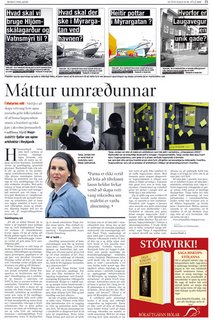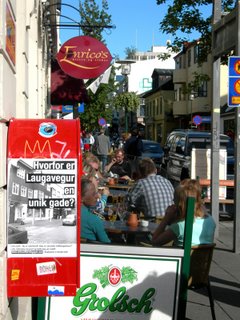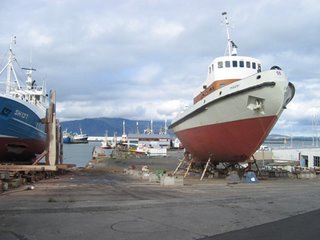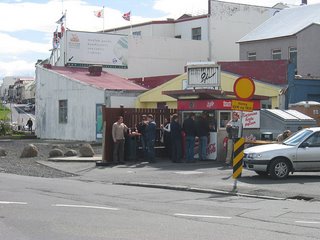Tuesday, October 24, 2006
"A town about to change"
 There seems to be a contitious discussion about specifically the the Myrargata development as well as the future of Reykjavik. An article in Reykjavik Mag in the month of september did spark off some interesting reactions.
There seems to be a contitious discussion about specifically the the Myrargata development as well as the future of Reykjavik. An article in Reykjavik Mag in the month of september did spark off some interesting reactions.One of them was an invitation to do a lecuture and a workshop at the Academy of Art in Reykjavik, which will take place the 21st of November. Here I will talk about Aesthetics and Public Participation in relation to urban development.
The lecture will be at Skipholt 1, room 113 at 1500 h.
See the article from Reykjavik Mag here: http://www.visir.is/apps/pbcs.dll/article?AID=2006108310056
Wednesday, August 16, 2006
Two section plans in Myragatan taken down
 A small article in Morgunbladid on the 15th of august talks about the Myragatan development.
A small article in Morgunbladid on the 15th of august talks about the Myragatan development.Two of the plans has been taken out of the overall planning proposal, one of them including the Alliance building. This has probably been debated and under its way for some time, but it do show that it is worth continuing the debate. Things do happen, public opinions and good arguments do matter!
Now it is time for crazy ideas and rethinking the possibilities of the Alliance building. Any suggestions?
Monday, August 07, 2006
Article in Morgunblaðið
 Gudfinna Mjöll Magnúsdóttir has written a very interesting article about the discussion, the blog and the posters, describing the project as 'open architecture'. Have a look in Morgunbladid on Sunday the 31st of July.
Gudfinna Mjöll Magnúsdóttir has written a very interesting article about the discussion, the blog and the posters, describing the project as 'open architecture'. Have a look in Morgunbladid on Sunday the 31st of July.Máttur umræðunnar. Í hlutarins eðli | Með því að skapa vettvang fyrir opna umræðu gefst fólki tækifæri til að koma hugmyndum sínum á framfæri og taka þátt í ákveðnu þróunarferli. Guðfinna Mjöll Magnúsdóttir fjallar um opinn arkitektúr í Reykjavík .
Friday, July 28, 2006
Ongoing debate -
 One of the very interesting debates on the blog has evolved around the concept of re-using existing harbour constructions and buildings in the Myrargata development. Specifically the idea of creating an indoor Fruit-Vedg and Fish marked in the
One of the very interesting debates on the blog has evolved around the concept of re-using existing harbour constructions and buildings in the Myrargata development. Specifically the idea of creating an indoor Fruit-Vedg and Fish marked in the The possibility of creating a unique and dynamic city exists. The developments must be debated to make an awareness of the already existing values and characteristics and to build upon, and to morph these into new visions, rather than to 'start from scratch'. The potential of
My stay in Reykjavík is coming to an end soon. I would like to thank everyone for the support, the interest, the mails and the discussions on and off the blog, held during the month of July. It has been very inspiring to me and hopefully to you as well. You can continue to comment on the blog, on the earlier discussions or create new. Please feel free to use this as inspiration, research or as a tool for communication and an opportunity to continue the debate on the future of the city.
I will follow the blog and keep commenting until at least October where I will be back in
Thursday, July 27, 2006
The Vatnsmyrí challenge - Áskorunin i Vatnsmyrí
 A new city within the city is about to be planned in the Vatnsmyrí area, around the site of the existing domestic airport. The competition brief states: “Here the citizens of Reykjavik have the opportunity to add a new dimension to their city and its social and cultural life, meet the challenge and adventure of the twenty-first century, and strengthen Reykjavík’s position as capital city.”
A new city within the city is about to be planned in the Vatnsmyrí area, around the site of the existing domestic airport. The competition brief states: “Here the citizens of Reykjavik have the opportunity to add a new dimension to their city and its social and cultural life, meet the challenge and adventure of the twenty-first century, and strengthen Reykjavík’s position as capital city.”So, now we must take this opportunity and ask the question of what this new city should be like. What should be the driving force of this new development? What is your vision for Vatnsmyrí?
The increasing competition between metropolitan cities in attracting people, business’ and tourists makes the future developments of cities ever so more important; to stand out, to have a clear identity, a distinct vision, to provide the necessary city functions modern city-life is in demand. In some ways there even seems to be a recipe for this, having a city of some historic value adding interesting modern architectural cultural monuments and some recreational public spaces. The reproduction or recycling of the same architects and large architectural monuments seems though somehow to diminish the difference between modern cities today. Therefore developing the city identity regarding place and context, avoiding the ‘MacDonaldism’ of cities is of most importance.
The size of the new Vatnsmyrí development is XLarge. This means that it is most likely to be a foreign architect or city planner, who will be executing the future development. I would like to refer to one of the earlier discussions on the blog, concerning the special situation in Iceland – Climate!
And would therefore like to raise the question once again; how is the climate factor being introduced into planning?
How can we make a new city quarter work with climate conditions such as wind, water and sun?
How can we make it relate to its context, the place and not end up creating an imported city-model from somewhere else?
Building on this land gives a rare opportunity to involve environmental aspects in town planning and by an intelligent integration with the remaining city, create a city model to stand out from the ordinary.
Wednesday, July 26, 2006
Ways of developing Laugavegur?


The proposed plans for Laugavegur seems to be driven by the inevitable 'marked' interest, seeing the obvious possibilities for real-estate, rather than for what the street and its houses means to Reykjavík today and could do in the future.
The problems are obvious today too. The coexistence of hummers, cars, bicycles, pedestrians etc. is particularly difficult in this street (as in
But one could wish for more public space, more 'street' surface or space left over to stop and pause. Therefore the problem raises the question if it is possible to both develop the commercial aspect of Laugavegur, since this is it’s nature, at the same time adding to the value of the public space? Is it possible to keep cars and still make room for ‘people’ to hang out, in a sheltered ‘Reykjavíkian’ way?
Of course, I think, one must question the number of houses to be taken down and what this means to the city. Is it right to do so? Is it necessary or can they be included in the overall development of Laugavegur anyhow?
Monday, July 24, 2006
Can we reuse existing habour structures for anything interesting?


Can we reuse some of the existing habour structures by reinterpreting and remodelling their use to suit a modern-city life?
By thinking about the city fabric as spaces of certian qualities, some of these with eternal and unique values, we can start to discuss new and other usees of i.e. the Daniels slippur and the Alliance building. By transforming these spaces and constructions into more suitable functions for modernday city life, we have the oportunity to create new public spaces. When reusing history and introducing the sitespecific nessity considering climate, the developing of the Reykjavik city identity is at the same time being remodelled and tied to its roots.
These initiatives doesn't have to big plans or vast developments, but can in a small scale start to introduce new functions in the existing habour, attracting more people and transforming it into a functional lively cityarea full of identity, over time. Any ideas? Please comment! Endilega Skrifið!
Sunday, July 23, 2006
Article in Fréttablaðið -
Tuesday, July 18, 2006
Developing Reykjavik! Mótun Reykjavikur!
I had a meeting with Salvör Jonsdottir today at the Skipulags-og byggingarsviði.
The discussion raised questions about the direction; the city was developing, since of course she is right in the middle of it all. We also talked about the interesting preliminary activities which has been going on in both Mýrargatan area as well as Vatnsmýri, involving the public.
I would like once again to encourage everyone to join the discussion in this blog, and to be as concrete and constructive as possible for ideas and concepts for a future vision of the urban life in the city. Does such a thing as a 'Reykjavik'ian' charachter exist? What gives identity to the city? I will onwards continue to blog about the different areas, and hereby hope that comments will be placed accordingly to the area and the specific questions raised by the different planning situations.
The qualities of
Concerning Mýrargatan: The fact that the fishing industry, which is such an important part of the Icelandic identity and still a part of the downtown area, is also unique. It is obvious that many qualities are connected to being close to the harbour and the water, for citizens, for small scale industries as well as bigger companies. Though, in the process of developing these areas it is important not to erase the identity with the activities, but to develop new ways of using some of these unique spaces for common cultural activities, which can give new life and meaning to the area. One hasn’t to look further than the Harbour front of
Please try to sign your comments, since this creates a more interesting discussion, than the anonymous ones.
Saturday, July 15, 2006
First posters and discussions

Today I started to put up posters around town. The first question was asked about the future of Laugarvegur. Many people reacted positively and quite a few good discussions came across.
One of these was with a man, who was not the least against taking the houses down i Laugarvegur, since he himself was situated in a very poor and run down property. This is a god point, which excactly brings out the nessesity of communitaction. Personaly I'm not agains taking houses down if they do not do their purpose, have any historical value or in any other way have outstanding qualities. But I do think it is so important to discuss what will replace it, not nessesarily the style and the acutal look of it, but the hight, the volume and the funtionality. It is important to bring the discussion in the public further than being only about aesthetics and onto talking about the qualities which have impact on the street life and the everyday use of the building. This is so important to take into consideration and to treat in a visionary way.
Wednesday, July 12, 2006
Meeting Pétur Ármannsson
Among several issues the need for expressing and formulating ideas about the public environment came up. Not by talking in styles, historical references or architectural details, but by talking about the qualities and characteristics of a given site or proposal, the functionality and the identity of the city in general. What does a given proposal has to offer the city and it's citizens? Architecture can be discussed in many other ways than only what it looks like and how many square meters it will contain. And it must be the responsibility of the architects to keep this discussion alive and present also to the general public, since the driving forces of recent developments rarely take this into account. The architect has a responsibility as a consultant to the public.
There is an importance for planning also for the small scale, the everyday life in the city, in large urban proposals.
Let me present my self. Má ég kynna mig.
During my stay here, I of course cannot but notice the amount of large planing projects at present in the city. With a general interest in the development of the urban environment, the seemingly rare or non-existent discussion in the public, about the future of this city, it has struck me.
The question of why this is, springs to mind. I would like to encourage and may be start a dicussion about the future of Reykjavik, which will involve so many people. In this context, I think it is important to exchange opinions and possible different views on planning and architecture, between as many people as possible. Being proffesionals or non-professionals. We all live here and have views and opinions on our everyday life, and therefore it is important to create an open debate and an awareness of the posibilities for the evolving city.
It is important to state, that the debate must simply start by asking questions. Questions about the spaces and activities we would like to see happening in the city. It is as much about defining the identity of the future city of Reykjavik, and the life which is lived within it, as it is about the specific proposed plans. It is about seeing the posibilities which lies inbetween the existing and the new.
I'm working on 3 posters, which can incourage a broader discussion, for a start. Whatch out in your nabourhood and in the inner city. And please do come back with comments!
Tanja Jordan
Tuesday, July 11, 2006
Welcome! Velkomin!

Welcome to the blog!
This is a blog about the development of the urban environment. More precisely the recent and future developments, the city of Reykjavik is facing. Reykjavik is the site for discussion at present.
I would like you to participate by commenting and giving your personal thoughts on how life should be shaped in the future city of Reykjavik.
I will comment daily during my stay in Reykjavik, which continues to the end of July.
I will blog in english, but feel free to post your comments either in English, Danish or Icelandic. Thanks for stopping by. More to come soon.
Tanja Jordan.

